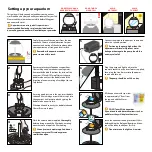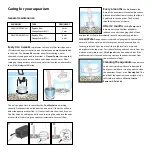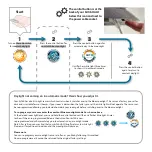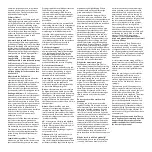
either live, in frozen packets or in vitamin
enriched jelly. Only buy live food from a
reputable source. Frozen foods should be
defrosted before being fed.
Pellets or flakes?
Eating flakes requires the fish to spend a lot
of time gulping at the water surface where it
could swallow too much air. Pellets are easier
for goldfish, for whom swallowing air can
contribute to swim bladder problems. Pellets
are also easier to administer than flakes and
are less likely to cloud the water. Smaller
pellets can be purchased for tropical fish and
minnows that are more suited to their
nutritional requirements.
How much food should I feed the fish?
Fish, especially goldfish, are programmed to
gobble up everything they can, far more than
they need. Everything a fish eats is excreted
into the water so the more the fish eats the
higher the risk of pollution becomes. A well
fed aquarium is more likely to develop poor
water quality, sick fish and algae problems.
Small goldfish
2-3 pellets per day
Large goldfish
3-4 pellets per day
Small tropical fish 4 micro pellets each per day
Goldfish and tropical fish have different
nutritional requirements, use an appropriate
food for each. Any food left in the aquarium
after two minutes should be removed.
Fish
will keep looking for food even when they
don’t need it.
What should I do if a fish dies?
If a fish dies you should remove it from the
aquarium immediately, if left in the
aquarium it will badly pollute the water. You
should try to establish why the fish died.
Make a note of anything that is abnormal.
Take a sample of your aquarium water to a
good aquatics retailer for testing and advice.
Dealing with disease
- Good aquarium
husbandry and fish selection is important -
prevention is better than cure. Chronic
stress, usually from poor water quality, can
make the fish susceptible to disease. If fish
show symptoms of a disease get the water
tested, if water quality is good then use a
suitable medication to treat the fish. If
water quality is poor this must be remedied
before or at the same time as using
medication; a sick fish in bad water is
unlikely to recover.
Make a note of all the abnormal symptoms
your fish are showing and get advice on
which medication to use. Most medications
include very clear instructions on diagnosis
and treatment, some also offer a help line.
The activated resins in the filter cartridge
should be removed during the treatment
period. Always follow the manufacturers
instructions.
Swim bladder problems
- The swim
bladder is a gas filled sack inside most fish
that controls their buoyancy in the water.
Problems with the swim bladder cause the
fish difficulty in swimming, and are
common with fantail goldfish. Bacteria
infections and air swallowing are thought
to be common causes of these problems.
Feeding a varied diet can help in
prevention.
Swim bladder problems are not usually life
threatening, however it can be a symptom of
a more serious disease. If a fish is suffering
badly for more than a day or two it can be
worth using a swim bladder medication.
Some fish suffer regular bouts of problems;
the fish is uncomfortable but soon recovers.
If, however, a fish constantly suffers with
swim bladder problems to the extent that it
affects quality of life, you may wish to
consider seeking advice from a vet.
Do fish need company?
It is unlikely that fish get lonely or bored,
however, animals do benefit from having a
more challenging lifestyle. Fish must be
compatible and goldfish should be of a
similar size when introduced to each other.
Shoaling fishes like minnows need to live in a
shoal. They can feel under threat of
predation without the security of a group.
Do I need to test the water?
Water tests should be routine for every fish
keeper. You can purchase a test kit to use at
home or take a sample along to a good
aquatics shop. It is important to test for
ammonia, nitrite, nitrate and pH.
Ammonia
- Ammonia (from fish waste)
level is likely to be quite high every time a
fish is added. Once the aquarium is
established, ammonia readings should be
no more than 0.02ppm (mg/litre)
Nitrite
- Like ammonia the level is likely to
be high when fish are added but once the
aquarium is established should be no more
than 0.2ppm. Subsequent high readings of
ammonia or nitrite could indicate that
biological filtration has broken down, that
the fish have been overfed or there is dirt in
the aquarium.
Nitrate
- Nitrate should be used as an
indicator of your aquarium’s hygiene. It
shouldn’t be more than 50ppm above the
level of nitrate in your tap water. If it is higher
then you should increase the frequency of
partial water changes and remove the cause
-usually over feeding.
pH
- is the measure of acidity and alkalinity
of water. pH 7 is neutral, 1-7 is acid, 7-12 is
alkaline. Most cold water fish prefer a pH of
7.5-8.5 tropical fish vary in their
requirements. Even tiny changes in pH are
very stressful to fish.
Filtration cycle
- Fish eat food, the waste
produced by the fish (ammonia) is
consumed by the filter bacteria and turned
into the less harmful pollutant nitrate. These
pollutants should be kept low with regular
maintenance and light feeding. If these
pollutants build up they will encourage
green water and poor fish health.
It is important that the biological filter is
given time to become established. A few
bacteria are introduced to the aquarium with
the water preparation chemicals so that 24
hours later one small goldfish can be added.
When the new fish is added the filter
bacteria start to multiply to catch up with
the amount of work they have to do. After
about 28 days there should be enough
bacteria to keep the water clean and safe.
The aquarium has ‘cycled’ and is ready for
one more goldfish. The aquarium has to go
through this cycle every time a new fish is
added. If more than one goldfish is added
there will be a lot more fish waste. The filter
bacteria cannot catch up quickly enough.
Adding a large fish or over feeding will have
the same effect. As the fish keep going to the
toilet the water becomes more and more
toxic, this can kill your fish. The less you put
into the aquarium the healthier the water
will be. Good fish keepers look after the
water, the fish look after themselves.
Why has the water turned green?
Green water is caused by algae. This is a
single celled plant that is naturally occurring
in aquariums. Small amounts of growth are
normal and easily dealt with during a normal
service. If large areas of algae grow or the
water goes very green very quickly this
indicates that there is a problem with the
water that’s causing the excess growth.
Algae needs sunlight and nutrients in order
to grow. Too much daylight, especially
during the summer months when the days
are longer and warmer, will cause algae to
thrive. Excess nutrients in the water, from
over feeding for example, will also cause
algae problems. It is easier to prevent algae
than to remove it once it has become a
problem.
Do I ever need to clean out the whole
aquarium?
Providing you follow instructions with
regard to feeding, fish selection, location
and maintenance you should never need to
empty and clean the aquarium. If you do
ever need to do this you should keep at
least 1/3rd of the old water and clean the
ceramic media in dirty water taken from the
aquarium (never clean in tap water).
Aquariums use filter bacteria to remove toxic
fish waste: creating a biological filter in the
ceramic media. These filter bacteria are not
already present in new aquariums, they will
start to multiply when they have a food
supply = fish waste. This means that when a
fish is first added there will be more fish
waste than there are filter bacteria to remove
it.
Why do I need to add fish gradually?
When the fish goes to the toilet ammonia
is created, this can be deadly to fish. The
bacteria convert the toxic ammonia into
nitrite and then a safer substance called
nitrate. When a fish is added the level of
ammonia and nitrite will rise sharply. As
the filter bacteria catch up they will keep
the ammonia and nitrite to a safe level and
the safer nitrate will steadily rise. This
process is called the ‘cycle’ and will take
about 28 days for one small goldfish.
This is potentially a risky time for the fish
and the level of ammonia should be
minimised by introducing a small fish and
not feeding too much. Even so, some fish
may not cope with life in very new
aquariums.
It is essential that fish are
introduced gradually at a rate of one small
fish every 28 days.
Filter bacteria need food (fish waste) so
that they can multiply. To multiply, the
bacteria need food and a constant supply
of oxygenated water. This is provided by
the air pump that must be left running 24
hours a day. There will only ever be enough
filter bacteria for the fish already in the
aquarium.
It is important that the biological filter is
given time to become established. A few
bacteria are introduced to the aquarium
with the water preparation chemicals and
24 hours later one small goldfish can be
added.
When the new fish goes to the toilet the
level of ammonia will start to rise. In
response, the filter bacteria multiply to
catch up with the amount of work they
have to do. The fish should be fed very
sparingly.
The ammonia level will continue to rise,
after a couple of weeks the filter bacteria
will have started to catch up and the level
will fall. After about 28 days the filter
bacteria should have caught up. The water
quality should then be good and the
aquarium is ready for one new fish. This
process will happen with every new fish.
If more than one goldfish is added at one
time then the level of ammonia could get
dangerously high. The extra ammonia could
make the fish very ill or even kill them. Too
much food or too large a fish will also create
extra ammonia.
Got a question not answered here? Get in
touch by phone, fax or email and we will be
happy to deal with your query. Contact
numbers and addresses can be found on
the reverse of this manual.



























